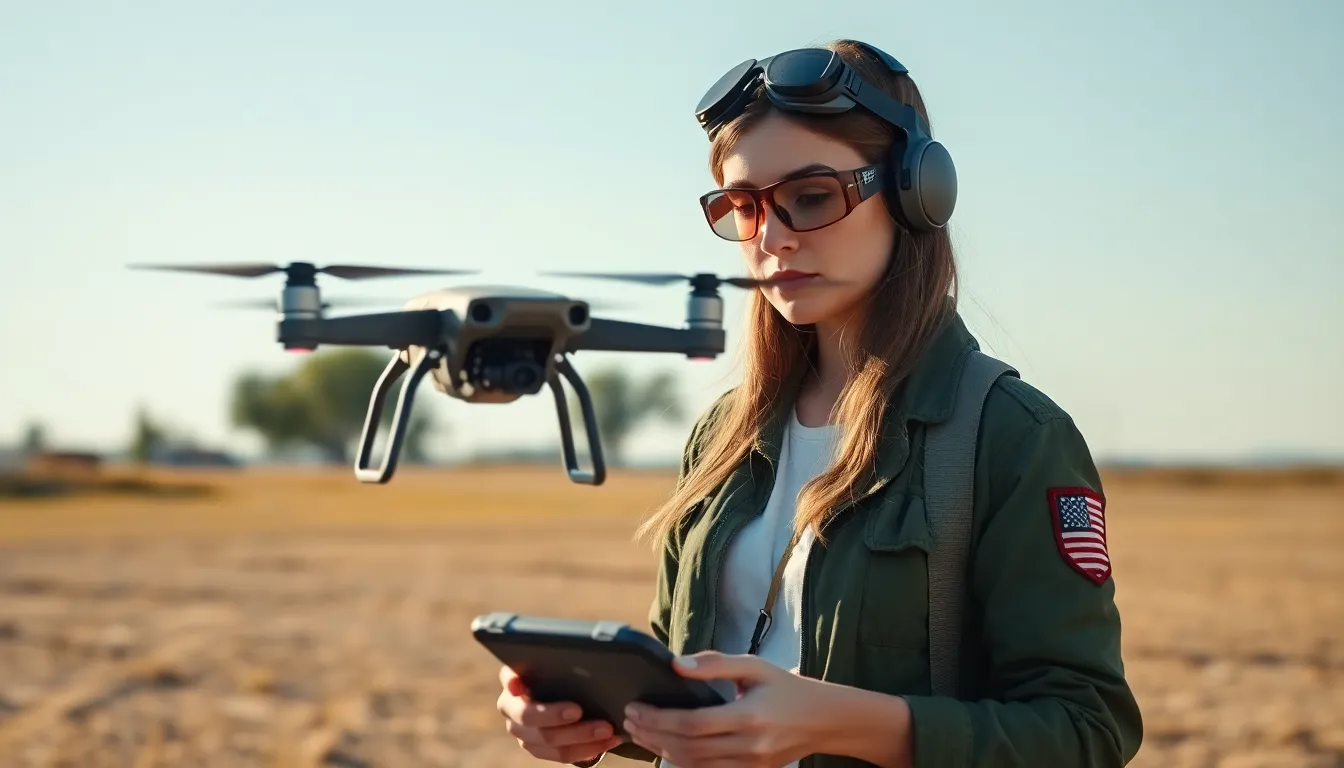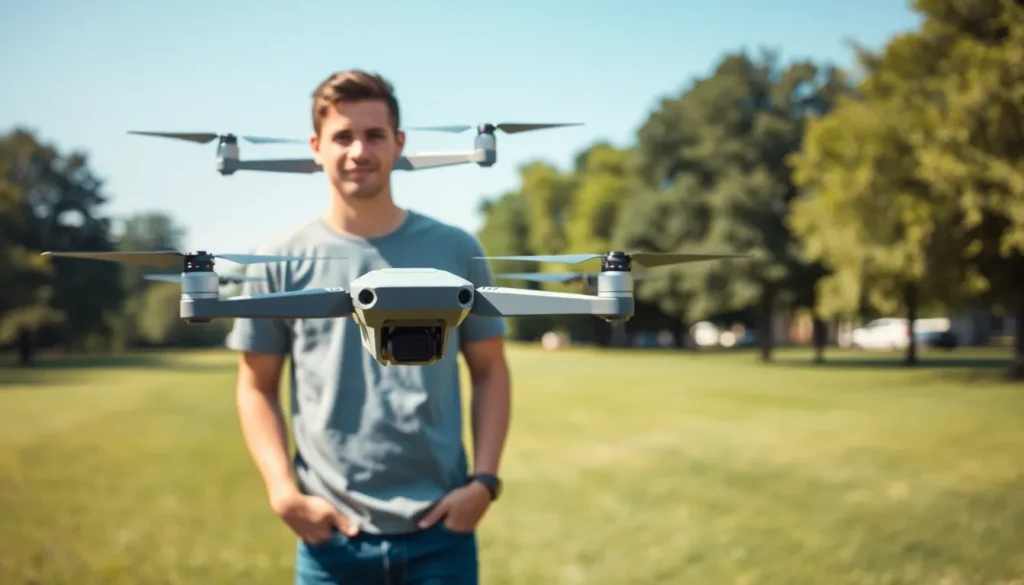Drones are the new cool kids on the block, soaring through the skies and capturing breathtaking views. But before anyone takes to the skies like a modern-day superhero, there are a few things to consider. Whether it’s your first flight or you’re a seasoned pilot looking to avoid a mid-air mishap, mastering the art of drone flying can turn potential disasters into epic adventures.
Table of Contents
ToggleEssential Drone Flying Tips
Pre-flight checks remain critical for safe drone operation. Inspect the drone’s battery levels, propellers, and overall condition before every flight. Familiarity with local regulations ensures compliance with airspace rules. Understanding no-fly zones helps prevent legal issues and avoids accidents.
Weather conditions significantly impact flying capabilities. Avoid flying in high winds or heavy rain, as these factors can lead to loss of control. A well-planned flight path enhances control over the drone and minimizes the risk of crashes. Utilize GPS features to assist with navigation and positioning.
Pilots should practice maintaining visual line-of-sight. Keeping the drone in view enables better responsiveness to potential obstacles. Understanding the drone’s controls and settings enhances piloting skills. Knowing how to use features like Return to Home provides a safety net in emergencies.
Battery management is essential for extended flight time. Monitor battery life closely and land before depletion to avoid crashes. Safety measures, like maintaining a safe distance from people and property, prevent accidents. Respect private property when flying, as trespassing can lead to complications.
Developing troubleshooting skills helps address issues while in flight. Familiarity with common problems allows for quick resolution. Joining local drone communities fosters knowledge sharing and offers support. Engaging with experienced pilots can provide valuable insights into improving flying techniques.
Preparing for Your Flight

Preparation is crucial for a successful drone flight. It enhances piloting skills and ensures safety.
Understanding Your Drone
Familiarity with drone specifications improves flying performance. Pilots should know their drone’s controls, range, and features. Battery capacity significantly influences flight duration, so monitoring it is essential. Camera settings and gimbal operations require prior understanding for capturing quality footage. Testing drone response to controls on the ground prepares pilots for actual flight. Each model has unique behaviors, making it vital to practice before taking off. Regular maintenance checks on propellers and other critical components extend the drone’s life.
Legal Regulations and Safety
Compliance with legal regulations ensures safe flying experiences. Local laws govern airspace and drone operations, mandating pilots to familiarize themselves with these rules. Proper registration with the FAA is mandatory for drones exceeding 0.55 pounds. Respecting no-fly zones protects sensitive areas and prevents fines. Maintaining situational awareness while flying minimizes accident risks. Keeping a visual line-of-sight allows for better control. Safety guidelines recommend avoiding crowds and private properties. Adhering to these rules not only promotes safety but also fosters responsible drone use within communities.
Flight Techniques for Beginners
Mastering flight techniques is essential for all drone pilots. Focusing on fundamental maneuvers enhances safety and enjoyment.
Taking Off and Landing
Taking off involves a smooth ascent. Pilots should use gradual throttle adjustments to maintain control. Landing requires careful attention; descending too quickly can damage the drone. When preparing to land, pilots aim for a clear, flat surface and reduce altitude evenly. It’s crucial to remain aware of the surroundings during both procedures to avoid obstacles. Practicing these actions frequently builds confidence for beginners.
Maneuvering in the Air
Maneuvering in the air demands practice and patience. Experimenting with different flight modes can help pilots discover their drone’s capabilities. Sharp turns and rapid dives showcase responsiveness but require caution to prevent loss of control. Pilots must anticipate wind shifts, which often affect flight paths. Staying calm while adjusting altitude and direction is vital for maintaining stability. Regular practice of these techniques ensures smoother, more enjoyable flights.
Advanced Flying Tips
Advanced flying techniques enhance a pilot’s skills and improve the overall drone experience. A focus on various elements, like aerial photography and navigating obstacles, proves invaluable for achieving better results.
Aerial Photography Techniques
Using settings like manual mode allows for better control over exposure, aperture, and shutter speed. Adjusting these settings lets pilots capture high-quality images in different lighting conditions. Incorporating techniques such as rule of thirds improves composition, creating more engaging visuals. Employing ND filters helps reduce glare and enhances colors, particularly in bright environments. Practicing diverse angles and heights reveals unique perspectives, offering stunning footage that intrigues viewers. Familiarity with gimbal settings allows for stabilization during dynamic maneuvers, ensuring smooth video quality. Pilots should also experiment with various flight paths for creative shots that tell compelling stories.
Navigating Obstacles
Maintaining focus while flying through complex environments is crucial. Developing spatial awareness helps pilots predict potential hazards and react swiftly. Identifying fixed objects like trees or buildings provides a better framework for safe navigation. Utilizing video feed from the drone can offer greater insights into surroundings, aiding in obstacle avoidance. Pilots must practice flying under and around structures to build confidence and improve proficiency. Implementing advanced sensors enhances detection of close-range obstacles, providing real-time alerts during flight. Regular practice in diverse environments cultivates adaptability, ensuring skillful navigation under various conditions.
Common Mistakes to Avoid
Understanding common mistakes is vital for safe drone operation. Below are key areas where pilots often err.
Overconfidence in Skills
Many pilots underestimate the complexities of drone flying. Mastering basic maneuvers doesn’t guarantee proficiency in advanced techniques. New pilots might find themselves in challenging situations if they venture too far beyond their skill level. Prioritizing practice and building confidence through gradual challenges enhances flying capabilities. Constantly pushing limits without adequate preparation often leads to accidents. Engaging with experienced pilots or taking courses can provide valuable insights. Being aware of personal limitations fosters safer flying experiences.
Ignoring Weather Conditions
Weather plays a crucial role in flight safety and performance. Flying in high winds or poor visibility can increase the likelihood of losing control. Pilots should always check local forecasts before taking off. Cloud cover, rain, and temperature shifts can impact drone functionality. Considering these factors ensures better decision-making during flights. While strong winds may seem manageable, they can create unexpected challenges. Adapting flight plans based on weather conditions helps maintain safety and control. Inconsistent weather can also affect battery life, making pre-flight assessments essential.
Drone flying offers an exhilarating experience when approached with care and knowledge. By prioritizing safety and preparation pilots can significantly enhance their flying skills and enjoyment. Understanding regulations and weather conditions is crucial for responsible operation.
Regular practice of essential maneuvers and advanced techniques not only builds confidence but also ensures smoother flights. Engaging with local communities can provide valuable insights and support, making the journey even more rewarding. With the right mindset and preparation anyone can master the art of drone flying while capturing breathtaking aerial views.

